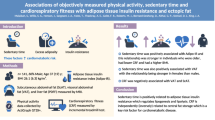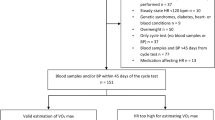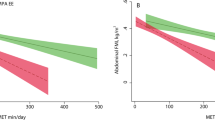Abstract
The purpose of this study was to determine whether cardiorespiratory fitness (CRF) is associated with lower abdominal adiposity in youth. Subjects included healthy 61 African-American and 52 white children and adolescents (age: 8–17 years). Body composition was measured by dual-energy X-ray absorptiometry and computed tomography. CRF (VO2max) was assessed using a graded maximal treadmill test. CRF was inversely related (P<0.05) to total adiposity, waist circumference, and visceral and abdominal subcutaneous adipose tissue (AT) independent of race. These findings remained significant (P<0.05) after adjusting for age, gender and pubertal status. Multiple regression analyses revealed that CRF is an independent contributor (P<0.05) of waist circumference, and visceral and abdominal subcutaneous AT after accounting for age, pubertal status, gender and body mass index percentile. Our observation suggest that in youth, CRF is associated with lower visceral and abdominal subcutaneous AT, and reinforces the notion that youth should engage in regular physical activity to improve aerobic fitness and reduce abdominal adiposity.
This is a preview of subscription content, access via your institution
Access options
Subscribe to this journal
Receive 12 print issues and online access
$259.00 per year
only $21.58 per issue
Buy this article
- Purchase on Springer Link
- Instant access to full article PDF
Prices may be subject to local taxes which are calculated during checkout

Similar content being viewed by others
References
Andreacci JL, Robertson RJ, Dube JJ, Aaron DJ, Balasekaran G, Arslanian SA (2004). Comparison of maximal oxygen consumption between black and white prepubertal and pubertal children. Pediatr Res 56, 706–713.
Andreacci JL, Robertson RJ, Dube JJ, Aaron DJ, Dixon CB, Arslanian SA (2005). Comparison of maximal oxygen consumption between obese black and white adolescents. Pediatr Res 58, 478–482.
Arslanian SA, Saad R, Lewy V, Danadian K, Janosky J (2002). Hyperinsulinemia in African-American children: decreased insulin clearance and increased insulin secretion and its relationship to insulin sensitivity. Diabetes 51, 3014–3019.
Bacha F, Saad R, Gungor N, Janosky J, Arslanian SA (2003). Obesity, regional fat distribution, and syndrome X in obese black versus white adolescents: race differential in diabetogenic and atherogenic risk factors. J Clin Endocrinol Metab 88, 2534–2540.
Cumming GR, Everatt D, Hastman L (1978). Bruce treadmill test in children: normal values in a clinic population. Am J Cardiol 41, 69–75.
Hayashi T, Boyko EJ, Leonetti DL, McNeely MJ, Newell-Morris L, Kahn SE et al. (2004). Visceral adiposity is an independent predictor of incident hypertension in Japanese Americans. Ann Intern Med 140, 992–1000.
Janssen I, Katzmarzyk PT, Ross R, Leon AS, Skinner JS, Rao DC et al. (2004). Fitness alters the associations of BMI and waist circumference with total and abdominal fat. Obes Res 12, 525–537.
Kuczmarski RJ, Ogden CL, Guo SS, Grummer-Strawn LM, Flegal KM, Mei Z et al. (2002). 2000 CDC growth charts for the United States: methods and development. Vital Health Stat 11, 1–190.
Lee S, Kuk JL, Davidson LE, Hudson R, Kilpatrick K, Graham TE et al. (2005). Exercise without weight loss is an effective strategy for obesity reduction in obese individuals with and without type 2 diabetes. J Appl Physiol 99, 1220–1225.
Nassis GP, Psarra G, Sidossis LS (2005). Central and total adiposity are lower in overweight and obese children with high cardiorespiratory fitness. Eur J Clin Nutr 59, 137–141.
Ross R, Aru J, Freeman J, Hudson R, Janssen I (2002). Abdominal adiposity and insulin resistance in obese men. Am J Physiol Endocrinol Metab 282, E657–E663.
Ross R, Dagnone D, Jones PJ, Smith H, Paddags A, Hudson R et al. (2000). Reduction in obesity and related comorbid conditions after diet-induced weight loss or exercise-induced weight loss in men. A randomized, controlled trial. Ann Intern Med 133, 92–103.
Ross R, Janssen I, Dawson J, Kungl AM, Kuk JL, Wong SL et al. (2004). Exercise-induced reduction in obesity and insulin resistance in women: a randomized controlled trial. Obes Res 12, 789–798.
Ross R, Katzmarzyk P (2003). Cardiorespiratory fitness is associated with diminished total and abdominal obesity independent of body mass index. Int J Obes Relat Metab Disord 27, 204–210.
Vanderburgh PM, Katch FI (1996). Ratio scaling of VO2max penalizes women with larger percent body fat, not lean body mass. Med Sci Sports Exerc 28, 1204–1208.
Wasserman K, Hansen JE, Sue DY, Whipp BJ, Casaburi R (1994). Principles of exercise testing and interpretation. 2nd edn. Philadelphia: Lea and Febiger.
Weiss R, Dufour S, Taksali SE, Tamborlane WV, Petersen KF, Bonadonna RC et al. (2003). Prediabetes in obese youth: a syndrome of impaired glucose tolerance, severe insulin resistance, and altered myocellular and abdominal fat partitioning. Lancet 362, 951–957.
Wong SL, Katzmarzyk P, Nichaman MZ, Church TS, Blair SN, Ross R (2004). Cardiorespiratory fitness is associated with lower abdominal fat independent of body mass index. Med Sci Sports Exerc 36, 286–291.
Acknowledgements
This work was supported by US Public Health Service Grants RO1-HD-27503, K24-HD-01357, General Clinical Research Center Grant MO1-RR-00084 and Eli Lilly and Company.
Author information
Authors and Affiliations
Corresponding author
Additional information
Contributors: SJL and SAA were responsible for study design, analysis and writing
Rights and permissions
About this article
Cite this article
Lee, S., Arslanian, S. Cardiorespiratory fitness and abdominal adiposity in youth. Eur J Clin Nutr 61, 561–565 (2007). https://doi.org/10.1038/sj.ejcn.1602541
Received:
Revised:
Accepted:
Published:
Issue Date:
DOI: https://doi.org/10.1038/sj.ejcn.1602541
Keywords
This article is cited by
-
Associations between physical fitness components with muscle ultrasound parameters in prepuberal children
International Journal of Obesity (2022)
-
Effects of fat distribution on lung function in young adults
Journal of Physiological Anthropology (2019)
-
Fitness level and body composition indices: cross-sectional study among Malaysian adolescent
BMC Public Health (2014)
-
Predicting Maintenance or Achievement of Healthy Weight in Children: The Impact of Changes in Physical Fitness
Obesity (2012)
-
Body Fat and Racial Genetic Admixture Are Associated With Aerobic Fitness Levels in a Multiethnic Pediatric Population
Obesity (2011)



